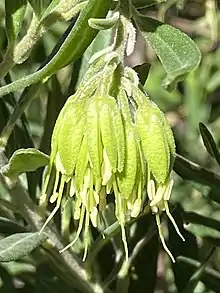| Leionema viridiflorum | |
|---|---|
 | |
| Growing in the Warrumbungles National Park | |
| Scientific classification | |
| Kingdom: | Plantae |
| Clade: | Tracheophytes |
| Clade: | Angiosperms |
| Clade: | Eudicots |
| Clade: | Rosids |
| Order: | Sapindales |
| Family: | Rutaceae |
| Genus: | Leionema |
| Species: | L. viridiflorum |
| Binomial name | |
| Leionema viridiflorum (Paul G.Wilson) Paul G.Wilson[1] | |
Leionema viridiflorum commonly known as green phebalium,[2] is a species of flowering plant in the family Rutaceae. It is a small shrub with pale yellow-greenish flowers in clusters at the end of branches from winter to early spring. It has a restricted distribution in northern New South Wales.
Description
Leionema viridiflorum is usually a small shrub to 1 m (3 ft 3 in) high with more or less needle-shaped stems covered in star-shaped, short, matted hairs. The leaves are mostly erect, narrowly oblong to oblong-elliptic, 20–40 mm (0.79–1.57 in) long, 4–8 mm (0.16–0.31 in) wide, wedge shaped at the base, apex lobed, smooth margins, rolled under or upward when dry, upper surface dotted with glands with occasional smooth to star-shaped hairs, underside more or less covered in star-shaped hairs. The inflorescence is a cluster of 6-12 pendulous flowers on a stalk 4–8 mm (0.16–0.31 in) long at the end of branches. The calyx are fleshy and hemispherical shaped. The erect, pale yellow-greenish petals are lance to narrowly oblong shaped, about 10 mm (0.39 in) long with occasional star-shaped, soft, erect hairs and the stamens twice the length of the petals. The fruit are a capsule, each segment about 6 mm (0.24 in) high, ending with a short beak. Flowering occurs from winter to early spring.[2][3]
Taxonomy and naming
This species was first formally described by Paul Wilson in 1970 and gave it the name Phebalium viridiflorum and the description was published in the journal Nuytsia.[4][5] In 1998 Paul Wilson changed the name to Leionema viridiflorum and published the name change in the journal Nuytsia.[6][7] The specific epithet (viridiflorum) means "green flowers".[8]
Distribution and habitat
Leionema viridiflorum grows usually in heath on trachyte outcrops in the Warrumbungle National Park and Mount Kaputar National Park in New South Wales.[3]
References
- ↑ "Leionema viridiflorum". Australian Plant Census. Retrieved 12 July 2020.
- 1 2 Weston, P.H; Harden, G.J. "Leionema viridiflorum". PlantNET-NSW flora online. Royal Botanic Gardens Sydney. Retrieved 14 July 2020.
- 1 2 Wilson, Paul G. (1999). Flora of Australia-Volume 26 Meliaceae, Rutaceae, Zygophyllaceae. Canberra/Melbourne: ABRS-Department of Environment & Heritage. p. 446. ISBN 9780643109551.
- ↑ Wilson, Paul G. "Phebalium viridiflorum". Australian Plant Name Index. Retrieved 14 July 2020.
- ↑ Wilson, Paul G. (1970). "A Taxonomic Revision of the Genera Crowea, Eriostemon and Phebalium (Rutaceae)". Nuytsia. 1 (1): 117–118. Retrieved 14 July 2020.
- ↑ Wilson, Paul G. "Leionema viridiflorum". Australian Plant Name Index. Retrieved 14 July 2020.
- ↑ Wilson, Paul G. (1998). "New species and nomenclatural changes in Phebalium and related genera (Rutaceae)". Nuytsia. 12 (2): 277. Retrieved 14 July 2020.
- ↑ Sharr, Francis Aubi; George, Alex (2019). Western Australian Plant Names and Their Meanings (3rd ed.). Kardinya, WA: Four Gables Press. p. 336. ISBN 9780958034180.